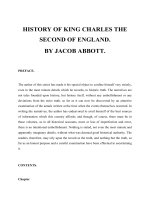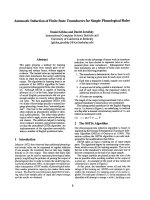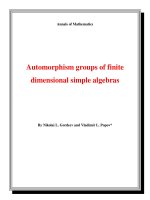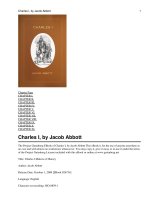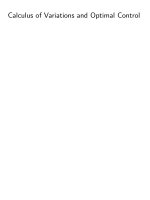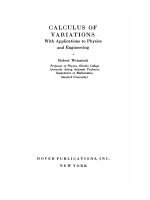Charles jordan calculus of finite differences (AMS chelsea publishing) american mathematical society (1950)
Bạn đang xem bản rút gọn của tài liệu. Xem và tải ngay bản đầy đủ của tài liệu tại đây (33.48 MB, 672 trang )
CALCULUS
OF
FINITE DIFFERENCES
BY
INTRODUCTION
BY
SECOND
EDITION
CHELSEA PUBLISHING COMPANY
NEW YORK, N.Y.
1950
www.pdfgrip.com
i
/
4:
PHINTED
IN THE IlNlTED STATES OF AMEHItX
www.pdfgrip.com
INTRODUCTION
There is more than mere coincidence in the fact that the
recent rapid growth in the theory and application of mathematical statistics has been accompanied by a revival in interest in
the Calculus of Finite Differences. The reason for this phenomena is clear: the student of mathematical statistics must now
regard the finite calculus as just as important a tool and prerequisite as the infinitesimal calculus.
To my mind, the progress that has been made to date in
the development of the finite calculus has been marked and
stimulated by the appearence of four outstanding texts.
The first of these was the treatise by George Boole that
appeared in 1860. I do not me& by this to underestimate the
valuable contributions of earlier writers on this subject or to
overlook the elaborate work of Lacroix.’
I merely wish to state
that Boole was the first to present’ this subject in a form best
suited to the needs of student and teacher.
The second milestone was the remarkable work of Narlund
that appeared in 1924. This book presented the first rigorous
treatment of the subject, and was written from the point of
view of the mathematician rather .than the statistician. It was
most oportune. ’
Steffensen’s Interpolation, the third of the four texts to
which ‘I have referred, presents an excellent treatment of one
section of the Calculus of Finite Differences, namely interpolation and summation formulae, and merits the commendation of
both mathematicians and statisticians.
I do not hesitate to predict that the fourth of the texts that
1 Volume 3 of Trait6 du Calcul Diffdrentiel et du Calcul Int&pl,
entitled Trait6 des diffbences et des shies. S. F, Lacroix, 1819.
www.pdfgrip.com
vi
I have in mind, Professor Jordan’s Calculus of Finite Differences, is destined to remain the classic treatment of this subject
- especially for statisticians - for many years to come.
Although an inspection of the table of contents reveals a
coverage so extensive that the work of more than 600 pages
might lead one at first to regard this book as an encyclopedia
on the subject, yet a reading of any chapter of the text will
impress the reader as a friendly lecture revealing an ununsual
appreciation of both rigor and the computing technique so important to the statistician.
The author has made a most thorough study of the literature
that has appeared during the last two centuries on the calculus
of finite differences and has not hesitated in resurrecting forgotten journal contributions and giving them the emphasis that
his long experience indicates they deserve in this day of mathematical statistics.
In a word, Professor Jordan’s work is a most readable and
detailed record of lectures on the Calculus of Finite Differences
which will certainly appeal tremendously to the statistician and
which could have been written only by one possessing a deep
appreciation of mathematical statistics.
Harry C. Carver.
’
www.pdfgrip.com
THE AUTHOR’S PREFACE
This book, a result of nineteen years’ lectures on the Calculus of Finite Differences, Probability, and Mathematical Statistics in the Budapest University of Technical and Economical
Sciences, and based on the venerable works of Stirling, Euler
and Boole, has been written especially for practical use, with
the object of shortening and facilitating the labours of the Computer. With this aim in view, some of the old and neglected,
though useful, methods have been utilized and further developed:
as for instance Stirling’s methods of summation, Boole’s symbolical methods, and Laplace’s method of Generating Functions,
which last is especially helpful for the resolution of equations of
partial differences,
The great practical value of Newton’s formula is shown;
this is in general little appreciated by the Computer and the
Statistician, who as a rule develop their functions in power
series, although they are primarily concerned with the differences
and sums of their functions, which in this case are hard to
compute, but easy withthe- use of Newton’s
formula. Even for
interpolation -itis more advisable to employ Newton’s expansion
than to expand the function into a power series.
The importance of Stirling’s numbers in Mathematical Calculus has not yet been fully recognised, and they are seldom
used. This is especially due to the fact that different authors
have reintroduced them under different definitions and notations,
often not knowing, or not mentioning, that they deal with the
same numbers. Since Stirling’s numbers are as important as
Bernoulli’s, or even more so, they should occupy a central position in the Calculus of Finite Differences, The demonstration of
I
“I.l
www.pdfgrip.com
a great number of formulae is considerably shortened by using
these numbers, and many new formulae are obtained by their
aid; for instance, those which express differences by derivatives
or vice versl; formulae for the operations x$X, and x& and many
others; formulae for the inversion of certain sums, for changing
the length of the interval of the differences, for summation of
reciprocal powers, etc.
In this book the functions especially useful in the Calculus
of Finite Differences, such as the Factorial, the Binomial Coefficient, the Digamma and Trigamma Functions, and the Bernoulli
and Euler Polynomials are fully treated. Moreover two species
of polynomials, even more useful, analogous to those of Bernoulli
and Euler, have been introduced; these are the Bernoulli polynomiali of the second kind (Q 89), and the Booze polynomials
6 113).
Some new methods which permit great simplifications, will
also be found, such as the method of interpolation without
printed differences (Q 133), which reduces the cost and size of
tables to a minimum. Though this formula has been especially
deduced for Computers working with a calculating machine, it
demands no more work of computation, even without this aid,
than Everett’s formula, which involves the use of the even differences. Of course, if a table contains both the odd and the
even differences, then interpolation by Newton’s formula is the
shortest way, But there are very few tables which contain the
first three differences, and hardly any with more than three,
which would make the table too large and too expensive;
moreover, the advantage of having the differences is not very .
great, provided one works with a machine, as has been shown,
even in the case of linear interpolation (3 133). So the printing
of the differences may be considered as superfluous.
The construction of Tables has been thoroughly treated
(§(j 126 and 133). This was by no means superfluous, since nearly
all the existing tables are much too large in comparison with the
precision they afford. A table ought to be constructed from the
point of view of the interpolation formula which is to be
employed. Indeed, if the degree of the interpolation, and the
www.pdfgrip.com
number of the decimals in the table, are given, then this determines the range or the interval of the table. But generally, as
is shown, the range chosen is ten or twenty times too large, or
the interval as much too small; and the table is therefore
unnecessarily bulky. If the table were reduced to the proper
dimensions, it would be easy and very useful to add another
table for the inverse function.
A method of approximation by aid of orthogonal polynomials, which greatly simplifies the operations, is given. Indeed,
the orthogonal polynomials are used only temporarily, and the
result obtained is expressed by Newton’s formula (8 142), so
that no tables are necessary for giving the numerical values of
the orthogonal polynomials.
In 3 143 an exceedingly simple method of graduation according to the principle of least squares is given, in which it is
only necessary to compute certain “orthogonal” moments corresponding to the data.
In the Chapter dealing with the numerical resolution of
equations, stress has been laid on the rule of False Posifion,
which, with the slight modification given (§$j 127 and 149, and
Example 1, in 8 134), enables us to attain the required precision
in a very few steps, so that it is preferable, for the Computer, to
every other method,
The Chapters on the Equations of Differences give only those
methods which really lead to practical results. The Equations of
Partial Differences have been especially considered. The method
shown for the determination of the necessary initial conditions
will be found very useful (8 181). The very seldom used, but
advantageous, way of solving Equations of Partial Differences
by Laplace’s method of Generating -Functions has been dealt with
and somewhat further developed (Q 183), and examples given.
The neglected method of Fourier, Lagrange and Ellis (Q 184) has
been treated in the same way.
Some formulae of Mathematical Analysis are briefly mentioned, with the object of giving as far as possible everything
necessary for the Computer.
Unfamiliar
notations, which make the reading of mathematical texts difficult and disagreeable, have been as far as
www.pdfgrip.com
5(
possible avoided. The principal notations used are given on pp.
xix-xxii. To obviate another difficulty of reading the works on
Finite Differences, in which nearly every author uses other definitions and notations, these are given, for all the principal authors,
in the respective paragraphs in the Bibliographical Notes.
Though this book has been written as has been said above,
especially for the use of the computer, nevertheless it may be
considered as an introductory volume to Mathematical Statistics
and to the Calculus of Probability.
I owe a debt of gratitude to my friend and colleague Mr.
A. &tics, Professor of Mathematics in the University of Budapest, who read the proofs and made many valuable suggestions;
moreover to Mr. Philip Redmond, who kindly revised the text
from the point of view of English.
www.pdfgrip.com
CONTENTS.
Chapter 1. On Operations.
5
6
§
Q
8
S
5
5
$j
8
(j
Q
8
1. Historical and Bibliographical Notes , . .
.
2. Definition of differences . . . . .
3. Operation of displacement . . . . . .
.
4. Operation of the mean . . . . . .
.
5. Symbolical Calculus . , , . . .
,
6. Symbolical methods , , . . . . .
.
.
7. Receding Differences . . . . , .
*
.
8. Central Differences . . . . . . .
.
.
9. Divided Differences , . . . . . .
.
.
10. Generating functions . , . . . .
.
11. General rules to determine generating functions
.
12. Expansion of functions into power series .
.
13. Expansion of function by aid of decomposition into
partial fractions . . . . . . ‘, . , .
0 14. Expansion of functions by aid of complex integrals ,
8 15. Expansion of a function by aid of difference equations
1
2
5
6
7
8
14
15
18
20
25
29
34
40
41
Chader II. Functions important in the Calculus of Finite
Differences.
8 16. The Factorial . . . . . . . . . .
§ 17. The Gamma function . . , . . . . .
Q 18. Incomplete Gamma function . . , . . . .
S 19. The Digamma function . . . . , . . .
6 20. The Trigamma function . . . . . . . ,
.
.
$ 21. Expansion of logf (x+1) into a power series
$j 22. The Binomial coefficient . . . . . . .
$j 23. Expansion of a function into a series of binomial
coefficients
.
.
.
.
.
.
.
.
.
.
.
45
53
56
58
60
61
62
74
www.pdfgrip.com
xii
Q 24. Beta-functions . . , . . . . , . ,
Q 25. Incomplete Beta-functions . . ! , . . .
Q 26. Exponential functions . . . . . , . .
8 27. Trigonometric functions . . . , . . . .
15 28, Alternate functions . . . . . . . . .
8 29. Functions whose differences or means are equal to
zero . . . . . . . . . . , . .
Q 30. Product of two functions. Differences . , . .
$j 31. Product of two functions. Means . . . , . .
80
83
87
88
92
94
94
98
Chapter III. Inverse Operation of Differences and Means. Sums.
$
8
Q
8
§
8
$f
Q
§
8
Q
8
Q
Q
Q
6
5
Q
32. Indefinite sums . . , . . . . , . .
33, Indefinite sum obtained by inversion . . . .
34, Indefinite sum obtained by summation by parts .
.
35. Summation by parts of alternate functions .
.
.
36. Indefinite sums determined by difference equations ,
37. Differences, sums and means of infinite series .
,
38. Inverse operation of the mean , . . . . .
.
.
39. Other methods of obtaining inverse means .
40. Sums . . . , , . . , . . . ,
41. Sums determined by indefinite sums , ; , , .
.
42. Sum of reciprocal factorials by indefinite sums .
43. Sums of exponential and trigonometric functions .
44. Sums of other Functions , . . . . . .
,
45. Determination of sums by symbolical formulae ,
.
46. Determination of sums by generating functions .
47. Determination of sums by geometrical considerations
48. Determination of sums by the Calculus of Probability
49. Determination of alternate sums starting from usual
sums
,
.
,
.
,
,
.
.
.
.
,
.
100
103
105
108
109
110
111
113
116
117
121
123
129
131
136
138
140
140
Chapter IV. Stirling’s Numbers.
8 50. Expansion of factorials into power series. Stirling’s
numbers of the first kind , . . . . . . 142
8 51. Determination of the Stirling numbers starting from
their definition , . . , , . . , . . 145
Q 52. Resolution of the difference equations . . . . 147
www.pdfgrip.com
..
Xl11
S 53. Transformation of a multiple sum “without repetition” into sums without restriction , . . . . 1 5 3
8 54. Stirling’s numbers expressed by sums. Limits .
159
8 55. Application of the Stirling numbers of the first kind 1 6 3
Q 56. Derivatives expressed by differences
164
5 57. Stirling numbers of the first kind obtained by proba:
bility
166
5 58. Stirling numbers of the sbcoid kfnd 1 : : : :
168
Q 59. Limits of expressions containing Stirling numbers of
the second kind . . . , . . . . . . 173
Q 60. Generating functions of the Stirling numbers of the
second kind . . . . . . . . . . .
174
8 61. Stirling numbers of the second kind obtained by
probability
.
,
.
,
.
.
.
,
.
.
. 177
S 62. Decomposition of products of prime numbers into
factors
.
.
.
.
.
.
.
.
.
.
.
. 179
$j 63. Application of the expansion of powers into series
of factorials , . . . . . . , . , . 181
Q 64. Formulae containing Stirling numbers of both kinds 182
$j 65. Inversion of sums and series. Sum equations
.
. 183
8 66, Deduction of certain formulae containing Stirling
numbers . . , . , . . . . , , . 185
8 67. Differences expressed by derivatives , . . . 189
f$ 68. Expansion of. a reciprocal factorial into a series of
reciprocal powers and vice versa , , . . . 192
Q 69. The operation 0 . , . . . . . , . 195
199
Q 70. The operation Y
Q 71. Operations AmD-” and &A’m : : : : : : 200
Q 72. Expansion of a function of function by aid of Stirling
204
numbers. Semi-invariants of Thiela .
$j 73. Expansion of a function into reciprocal factorial
series and into reciprocal power series , . , . 212
Q 74. Expansion of the function l/y” into a series of
powers of x . . , . , . . , , . , 216
Q 75. Changing the origin of the intervals . . . . , 219
Q 76. Changing the length of the interval , . . . - 220
$j 77. Stirling’s polynomials , . . , . . , . 224
www.pdfgrip.com
XiV
Chapters
Q
Q
($
5
8
8
Q
zj
8
5
5
8
5
8
8
Q
8
5
8
Q
§
(j
V. Bernoulli Polynomials and Numbers.
78. Bernoulli polynomials of the first kind . , . , 2 3 0
79. Particular cases of ,the Bernoulli polynomials
.
. 236
80. Symmetry of the Bernoulli polynomials . . . . 238
81. Operations performed on the Bernoulli polynomial , 2 4 0
82. Expansion of the Bernoulli polynomial into a Fourier
series. Limits. Sum of reciprocal power series .
. 242
,
83. Application of the Bernoulli polynomials .
246
84. Expansion of a polynomial into Bernoulli polynomials 248
85. Expansion of functions into Bernoulli polynomials.
Generating
functions
,
,
.
.
.
.
.
. 250
86. Raabe’s multiplication theorem of the Bernoulli
polynomials
.
.
.
.
.
.
.
.
,
.
, 252
87. The Bernoulli series . . . , . , . . 253
88. The Maclaurin-Euler summation formula . , . 2 6 0
265
89. Bernoulli polynomials of the second kind
90. Symmetry of the Bernoulli polynomials of the second
kind.
.
.
.
.
,
.
,
.
.
.
.
. 268
91. Extrema of the polynomials .
.
.
.
, 269
272
92. Particular cases of the polynomtals
’
93. Limits of the numbers b,, and of the polynomials ;I,,(;) 272
94. Operations on the Bernoulli polynomials of the
275
second kind .
95. Expansion of the Bernoulh polynomials ’ of ’ the
276
second kind , .
277
96. Application of the polynomials : : : : :
97. Expansion of a polynomial into a series of Bernoulli
polynomials of the second kind . . . . . 277
.
.
. 280
98. The Bernoulli series of the second kind .
99. Gregory’s summation formula . . . . . . 284
Chapter VI. Euler’s and Boole’s polynomials. Sums of
reciprocal powers.
Q 100. Euler’s polynomials . .’ . . .
Q 101. Symmetry of the Euler polynomials
§ 102. Expansion of the Euler polynomials into
of Bernoulli polynomials of the first kind
. , . 288
. . . . 292
a series
.
. 295
.
www.pdfgrip.com
-
5 103. Operations on the Euler polynomials . , . .
8 104. The Tangent-coefficients . . . . , , .
S 105. Euler numbers . . , , . . . . . .
$j 106. Limits of the Euler polynomials and numbers . ,
Q 107. Expansion of the Euler polynomials into Fourier
series
,
.
.
,
.
.
.
.
.
.
.
,
Q 108. Application of the Euler polynomials .
8 109. Expansion of a polynomial into a series of Euler
polynomials
.
.
.
.
.
.
.
.
.
.
Q 110. Multiplication theorem of the Euler polynomials .
.
5 111. Expansion of a function into an Euler series .
S 112. Boole’s first summation formula . . . , ,
Q 113.
Boole’s polynomials . . . . . . . .
Q 114. Operations on the Boole polynomials. Differences .
Q 115. Expansion of the Boole polynomials into a series of
Bernoulli polynomials of the second kind . . .
.
5 116. Expansion of a function into Boole polynomials
S 117. Boole’s second summation formula . , . . ,
Q 118. Sums of reciprocal powers. Sum of l/x by aid of
the digamma function . . . . , . , .
.
§ 119. Sum of l/x’ by aid of the trigamma function .
3 120. Sum of a rational fraction . . , . . . .
.
.
.
6 121. Sum of reciprocal powers. Sum of l/x”’ .
8 122. Sum of alternate reciprocal powers by the i)‘,(x)
function
.
.
.
.
.
.
.
.
.
.
.
296
298
300
302
303
306
307
311
. 313
315
317
320
321
322
323
325
330
335
338
347
Chapter VII. Expansion of Functions, interpolation,
Construction of Tables.
I
6 123. Expansion of a Function into a series of polynomials 355
357
.
.
,
.
Q 124. The Newton series .
$j 125. Interpolation by aid of Newton’s Formula and n
Construction of Tables . . . . . . , “360
$ 126. Inverse interpolation by Newton’s formula . I. 366
Q 127. Interpolation by the Gauss series . , . . . 368
3 128. The Bessel and the Stirling series . , . . . 373
5 129. Everett’s formula . . . . , . . . . 376
.
. 381
$j 130. Inverse interpolation by Everett’s formula .
$ 131. Lagrange’s interpolation formula . , . . . 385
I
www.pdfgrip.com
xvi
$ 132. Interpolation formula without printed differences.
Remarks on the construction of tables .
8 133. Inverse Interpolation by aid of the formula of the
preceding paragraph . , . . . . . ,
,
5 134. Precision of the interpolation formulae . . .
Q 135. General Problem of Interpolation . . , , .
390
411
417
420
Chapter VIII. Approximation and Graduation.
Q 136. Approximation according to the principle of
moments
.
.
.
.
.
.
.
.
.
.
. 422
S 137. Examples of function chosen , . . . , . 426
Q 138. Expansion of a Function into a series of Legendre’s
polynomials
.
,
.
.
.
.
.
.
.
. 434
Q 139. Orthogonal polynomials with respect to x=x,,,
x, ( . . . , X.\L1
. , . . . , . . . , 426
8 140. Mathematical properties of the orthogonal polynomials
.
,
.
.
.
.
,
.
.
.
. 442
$i 141. Expansion of a function into a series of orthogonal
polynomials
.
.
.
,
.
,
.
.
.
. 447
9 142. Approximation of a function given for t=O, 1,2, . . . ,
iv-l
.
.
.
.
.
.
.
.
.
.
.
. 451
.
. 456
Q 143. Graduation by the method of least squares
8 144. Computation of the binomial moments . . , . 460
. 463
.
.
.
.
.
.
,
Q 145. Fourier series ,
8 146. Approximation by trigonometric functions of discontinuous variables . . . , . . , . 465
Q 147. Hermite polynomials , . , . . . , . 467
8 148. G. polynomials . , , . , . . , . 473
Chapter IX. Numerical resolution of equations. Numerical
integration.
Q
9
$i
3
Q
Q
. . .
149. Method of False Position. Regula Falsi
~
.
.
150. The Newton-Raphson method . . .
s
,
.
151, Method of Iteration
,
,
*
152. Daniel Bernoulli’s method : : : :
. . .
153. The Ch’in-Vieta-Horner method
154. Root-squaring method. Dandelin,’ Lobsitchevsky,
.
.. .
Graeffe
.
.
,
,
.
,
,
.
486
489
492
494
496
503
www.pdfgrip.com
xvii
$j 155. Numerical Integration , , , . . , , . 512
8 156. Hardy and Weddle’s formulae . . . . . . 516
S, 157. The Gauss-Legendre method . . . , . , 517
$j 158. Tchebichef’s formula . . . . . . , . 519
8 159. Numerical integration of functions expanded into
a series of their differences . , , , , . 524
, 527
Q 160. Numerical resolution of differential equations .
Chapter X. Functions of several independent variables.
Q 161. Functions of two variables ,
530
Q 162. Interpolation in a double entry’tabie : : : : 532
5 163. Functions of three variables . . . , . , 541
Chapter XI. Difference Equations.
-
I
8 164. Genesis of difference equations . . . . . .
8 165. Homogeneous linear difference equations, constant
coefficients . . . . . . . . . . .
.
Q 166. Characteristic equations with multiple roots ’ ,
Q 167. Negative roots . , . , ., . , , . ,
Q 168. Complex roots . . . . . , . , . .
$j 169. Complete linear equations of differences with
constant coefficients . . , . . , , .
8 170. Determination of the particular solution in the
general case , . , , . . :
, , .
.
. .
fj 171. Method of the arbitrary constants .
S 172. Resolution of linear equations of differences by
aid of generating functions . . . . . . ,
$j 173. Homogeneous linear equations of the first order
with variable coefficients . . , , , . .
Q 174. Laplace’s method for solving linear homogeneous
,
difference equations with variable coefficients .
Q 175. Complete linear equations of differences of the first
order with variable coefficients . . . . .
8 176. Reducible linear equations of differences with variable coefficients , . . . , . . . ,
6 177. Linear equations of differences whose coefficients
are polynomials of x, solved by the method of
generating functions . . , . . . , .
543
545
549
552
554
557
564
569
572
576
579
583
584
586
www.pdfgrip.com
...
XYll,
8 178, Andre’s method for solving difference equations
$j 179. Sum equations which are reducible to equations of
.
differences .
Q 180. Simultaneous linear’ equations of differences with
constant coefficients . , . , . . , .
587
599
600
Chapter XIII. Equations of Partial Differences.
Q 181. Introduction
8 182. Resolution of lidear’equatiohs of partial differences
with constant coefficients by Laplace’s method of
generating f.unctions
. . , . , , . .
8 183. Boole’s symbolical method for solving equations of
partial
differences
.
.
.
.
.
.
$ 184. Method of Fourier, Lagrange, and Ellis for solving
equations of partial differences . . . . . .
$ 185. Homogeneous linear equations of mixed differences
6 186. Difference equations of three independent variables
§ 187, Differences equations of four independent variables
604
607
616
619
632
633
638
1
www.pdfgrip.com
NOTATIONS AND DEFINITIONS
Pages *
-
(I,, coefficient of the Bernoulli po!ynomial .
&(x), arithmetical mean of x . . , . .
,
, .
&, , binomial moment of order n ,
B,, , Bernoulli numbers . . . . . .
PI(x),
function
.
.
,
.
.
,
.
.
B(x,y),
Beta function . . . . . . .
B,(p,q), incomplete Beta function , , , .
numbers (interpolation) . . , , .
numbers
(approximation)
.
.
.
.
;zk.*
C, Euler’s constant . . . . . . .
C ,,Iy, numbers . . . , . . , . .
Em, 1 numbers . , . . , . . . ,
Cmi, Cotes numbers (only in 5 131 and Q 155) .
.
C,(x), (interpolation) . , . . , .
.
%nll ‘ numbers (approximation) . . .
.
K,,!,, numbers (approximation) . , ,
D , derivative . . . . . . . .
.
A, difference, interval one . . . .
,
A, difference, interval h . . , . .
A, difference with respect to X, interval h
x.h
6,
.g,
central difference . . . . .
divided difference . . . .
A-l, inverse difference . . . .
F(x), digamma function . . . .
E, operation of displacement . . .
E,, Euler numbers . . . , .
E,(x), Euler polynomial of degree n .
e,, coefficient of the Euler polynomial ,
,
.
.
,
.
a
.
.
,
.
,
.
,
.
,
.
.
.
.
,
.
.
.
.
,
.
,
.
*
.
.
.
.
.
.
.
,
.
.
,
.
,
232
427
163
233
341
80
83
395
449
58
150
171
388
395
453
454
3
.
2
.
2
,
.
.
,
,
.
,
.
.
.
.
.
.
.
,
.
.
:
.
,
,
.
,
.
.
.
2
15
18
101
58
6
LOO
, 288
, 290
www.pdfgrip.com
xs
B, , tangent-coefficient .
E , , ( S ) , coefficients in Everett’s’formula (only in QQ ;29, ;30)
q,,(x), Bernoulli polynomial of degree R . . . . ,
4n(x), function, (Czuber, Jahnke) , , . . . . .
G,
generating function . . . , . . . , .
G, = G,(x), polynomial of degree n . , . . , ,
T(X), gamma function . . . . . . . . . .
r,(p+l),
incomplete gamma function . , , . .
e yz,,, , numbers, (graduation) . . . . , . , .
H, = Hn(x), Hermite polynomial of degree R , . . .
I(u,p), incomplete gamma function divided by the corresponding complete function . . , . . .
I, (p,q), incomplete Beta function divided by the corresponding complete function . . , . , .
h , (interpolation) , . . . . . . . . . .
L,,(x), Lagrange polynomial of degree n , , . , .
.2”(f); Langrange polynomial , . . , . , . .
M, operation of the mean , , . . . , . . .
mean
.
.
, .’
,
.
.
.
.
.
,
Fe central
M-l, inverse mean . . . . . . . , , . .
d”, power-moment of degree n . . . . , . .
+mn,
factorial-moment of degree n . . . . . .
P(n,i),
numbers
.
.
.
.
.
.
.
.
,
,
,
w(m,x), Poisson’s probability function . , . , ,
y”(x), Bernoulli polynomial of the second kind of degree
,
n, (except in 5 77) . . . . . . . .v”(x), Stirling polynomials (only in 5 77) . . . V
.
Yn
(x),
psi-function . . . . . , . . .
.
.
Y,
operation . . . . , , . , . . .
.
.
,
X, indefinite sum or inverse difference A-’
.
II
Zf(x),
definition of , . . . . . . .
.X==t2
S
sum of reciprocal powers of degree m, (1,x) .
sz”, sum of reciprocal powers of degree m (2,m) ,
p,, Stirling numbers of the first kind . . . .
e,, Stirling numbers of the second kind . . .
&r,
mean binomial moment . . . , . .
F(x),
trigamma function , . . , , . ,
298
378
231
403
21
473
53
56
458
467
56
83
394
385
512
6
15
111
163
163
221
57
265
224
342
199
101
.
,
117
,
,
.
.
,
.
. 244
.ooo
. 142
, 168
. 448
.
60
www.pdfgrip.com
xsi
6,, mean orthogonal moments . . . . . . .
0,
operation , , . . , , , , . , . ,
U,(x), orthogonal polynomial of degree m . . . ,
(x),, , factorial of degree n . . . . . , . . ,
(x),,~, generalised factorial of degree n . . . . ,
x!=1.2.3
.,..
x
.
.
.
,
.
.
. . , .
E ,
I I
X
I n 1 r,b
1
-
C”(X),
binomial
,
coefficient
generalised
Boole
of
binomial
polynomial
of
degree
n
.
coefficient
degree’ n
.
.
.
.
.
.
.
.
.
.
.
,
.
.
450
195
439
45
45
53
.
64
.
70
317
www.pdfgrip.com
\
(
Ii,
.-_
-
.”
.
.
www.pdfgrip.com
CHAPTER I.
ON OPERATIONS.
8 1. Historical and Bibliographical Notes. The most
important conception of Mathematical Analysis is that of the
function. If to a given value of x a certain value of y correspond,
we say that y is a function of the independent variable x.
Two sorts of functions are to be distinguished. First, functions in which the variable x may take every possible value in a
given interval; that is, the variable is continuous. These functions belong to the domain of Infinitesimal Calculus. Secondly,
functions in which the variable x takes only the given values
x09 x,, x2, - . . x,; then the variable is discontinuous. To such
functions the methods of Infinitesimal Calculus are not applicable.
The Calculus of Finite Differences deals especially with such
functions, but it may be applied to both categories.
The origin of this Calculus may be ascribed to Brook
Taylor’s Methodus ,Incrementorum (London , 1717), but the real
founder of the theory was Jacob Stirling, who in his Methodus
Differentialis (London , 1730) solved very advanced questions,
and gave useful methods, introducing the famous Stirling
numbers; these, though hitherto neglected, will form the backbone of the Calculus of Finite Differences.
The first treatise on this Calculus is contained in Leonhardo
EuZero, Institutiones Calculi Differentialis (Academiae Imperialis Scientiarum Petropolitanae, 1755. See also Opera Omnia,
Series I. Vol. X. 1913) in which he was the first to introduce the
symbol A for the differences, which is universally used now.
From the early works on this subject the interesting article
“Difference” in the Encyclopedic Mtthodique (Paris, 17841,
www.pdfgrip.com
2
written by l’Abb6 Charles Bossut, should be mentioned,
also,
F. S. Lacroix’s “Trait6 des differences et series”
Paris, 1800.
9 2. Definition of the differences, A function f(x) is given
for x f x,,, x,, x,, . . . , x,,. In the general case these values are
not equidistant. To deal with such functions, the “Divided Differences” have been introduced, We shall see them later (8 9).
Newton’s general interpolation formula is based on these differences. The Calculus, when working with divided differences,
is always complicated, The real advantages of the theory of
Finite Differences are shown only if the values of the variable
x are equidistant; that is if
#i+l -xi = h
a
-
where h is independent of i.
In this case, the first difference of f(x) will be defined by
the increment of f(x) corresponding to a given increment h of
the variable x. Therefore, denoting the first difference by A we
shall have
Af(x) = f ( x + h ) - f ( x ) .
The symbol A is not complete; in fact the independent variable and its increment should
also be indicated. For instance
-.
thus:
A
1. h
This must be done every time if there is any danger of a
misunderstanding, and therefore A must be considered as an
abbreviation of the symbol above.
-----.
1 The most important treatises on the Calculus of Finite Differences
are the following:
George Boofe, A treatise on the Calculus of Finite Differences,
Cambridge, 1860.
A. A. Morkoff, Differenzenrechnung, Leipzig, 18%.
D. Sefiuonoff, Lehrbuch der Differenzenrcchnung, Leipzig, 1904.
E. T. Whitfaker and G. Robinson, Calculus of Observations, London,
1924.
‘N. E. Niirlund. Diffcrenzenrechnung, Berlin, 1924.
J. F. Sfeffensen, Interpolation, London, 1927.
J. B. Scarborough, Numerical Mathematical Analysis, Baltimore, 1930.
G. Kotuafewski, Interpolation und gen~herte Quadratur, Leipzig. 1932.
L. M. Milne-Thomson. The Calculus of Finite Differences, London, 1933.
www.pdfgrip.com
3
Often the independent variable is obvious, but not the
increment; then we shall write A, omitting h only in the case
h
of h = 2.
If the increment of x is equal to one, then the formulae of
the Calculus are much simplified. Since it is always possible to
introduce into the function f(x) a new variable whose increment
is equal to one, we shall generally do so. For instance if y=f(x)
and the increment of x is h, then we put x=a+hE; from this it
follows that AE=l; that is, 6 will increase by one if x increases
by h. Therefore, starting from f(x) we find
f(x) = f(a+Zh) = F(i)
and operate on F(S); putting finally into the results obtained
(x-+)/h instead of E.
We shall call second difference of f(x) the difference of
its first difference. Denoting it by Azf (x) we have
li)W =
+[$f(x)l =
;f;~+hl -$f(x) =
= f (x+2h) - 2f (x+h) + f(x).
In the same manner the n-th difference of f(x) will be
defined by
L?“‘(x) =
+[;“‘f(x)l =
p-‘f(x+h) -p”-+(x) .
Remark. In Infinitesimal Calculus the first derivative of a
df (4
function f(x) generally denoted by 7, or more briefly by
Df (x) (if there can be no misunderstanding), is given by
y(x)
Df(x) = lim f (x+hLv f(x) = lim - .
/a=0
IsO
h
Moreover it is shown that the R -th derivative of f(x) is
9”‘(x)
Dnf(x) = l i m ___
h=O
h”
*
If a function of continuous variable is given, we may
determine the derivatives and the integral of the function by
using the methods of Infinitesimal Calculus. From the point of
I
www.pdfgrip.com
4
view of the Calculus of Finite Differences these functions are
treated exactly in the same manner as those of a discontinuous
variable; WC may determine the differences, and the sum of the
function; but the increment h and the beginning of the intervals
must be given, For instance, log x may be given by a table from
x=1000 to x=10000, where h=Z.
Generally we write the values of the function in the first
column of a table, the first differences in
the second column,
the third, and so on.
the second differences in
If we begin the first column with f(u), then we shall write
the first difference tf (a) in the line between f(a) and f (a+h) ;
the second difference A’f(a)
will be put into the row between
N(a) a n d ?f(a+h) and so on. We have.
h
f(a)
p’(a)
?” (al
f (a+4
I
I
+!
(
a
t
2
h)
f(a+3h)
y’bl
$f(a+h)
f (a-t2h)
ef(a-tW
b’f(afh)
(W4
+“f la-i- 4
b’f (a-t 2h)
$lf (4
pf(a-1
;“f (a-I-2hJ
11)
j
+‘f (at-3h)
fb+W
+f(a+W
f b+W
It should be noted that
proceeding in this way, the
expressions with the same argument are put in a descending
line; and that the arguments in each horizontal line are decreasing.
The reason is that the notation
used above for
the differences is nof symmetric with respect to the argument.
www.pdfgrip.com
5
I
have
Differences of functions with negative arguments. If we
A f ( x ) = f(x+h) - f ( x ) = q(x)
h
b @’
1
,..‘i
then according to our definition
Qf(-x)
= f(-x-h)
-f(-x).
a:;; -*
(6.,i‘f
G .i “‘tl.,
=(-‘,-yg(-Y)
F1;-{1-+ k’)“Lp’(-r..,,ni\)
that is, the argumeit -x of the function is diminished by h.
In the same manner we should obtain
A f ( - x ) = ---(-x-h)
4”’ f-x) =
(-l)mg/(-x-mhl;
y’(x)
=
p f ( x ) ,
This formula will be very useful in the following.
Difference of a sum. It is easy to show that
A[f, (4 + f, (4 + ’ - ’ +f,WI = Af,(x) +Af,W +.-. +AfnM
moreover if C is a constant that
= CAf(x).
.
According to these rules the difference of a polynomial
ACf(x)
iS
-
!:I
wi .*,I
r f E?&‘!,).j
qi~y~.Li”‘t.-“:
From this it follows that
;, s i
f,
A[a,+a,x+a,x’+ . . . +anxn] = a,Ax + a&x’ + . . , + anAx”.
$3 3, Operation of displacement.2 An important operation
2 Boole denoted this operation by D; but since D is now universally
used as a symbol for derivation, it had to be changed. De la Valfhe Poussm
in his Cours d’Analyse Infinitesimale [1922, Tome II, p. 3291 denoted this
operation by Pseudodelta v. We have adopted here E since this is generally
used in England. So for instance in
W. F. Sheppard, Encyclopaedia Britannica, the ll-th edition, 1910, in VOC.
Differences (Calculus of., .) Vol. VIII p. 223.
E. k. Whitfder and G. Robinson, lot. cit. 1, p. 4.
J. E. Steffken, lot. cit. 1. p. 4.
L. M. Milne-Thomson. lot. cit. 1, p. 31.
This operation has already been considered by L. F. A. Arbogd [Du calcul
des derivations, Strasbourg, MOO]; he called it an operation of “6tat varie”.
F. Crrsoroti proposed for this operation the symbol @ which was also used
b y Pjncherle [lot. c i t . 41.
C. Jordan, in his Cours d’Analyse [Second edition tom. I, p, 1151 has
also introduced this operation and deduced several formulae by aid of
notation was
symbolical methods. His
f n = f(x + nh).
